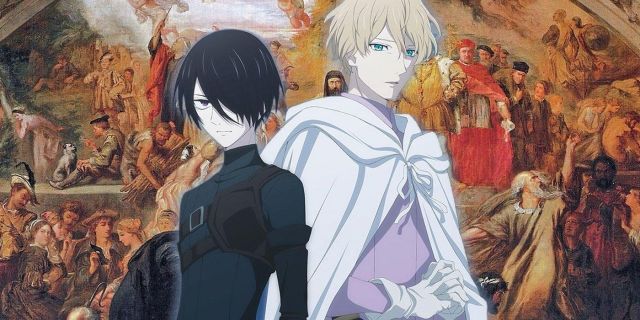Shakespeare is, for obvious reasons, not a name commonly associated with anime. The two are separated by hundreds of years, thousands of miles, and two entirely different languages. Yet, Japanese media already has strong ties to Shakespeare’s canon, as his plays are global in the the theater and drama industries. Akira Kurosawa’s iconic and groundbreaking films Throne of Blood and Ran, adaptations of Macbeth and King Lear, respectively. Anime adaptations of Shakespeare plays have also been well-received in the anime community, such as the Richard III adaptation Requiem of the Rose King, as well as Romeo X Juliet. There are a lot of truly moving stories that could spring up in the anime space by exploring Shakespeare’s themes and narratives in anime, even if only in a minor way.
Shakepeare’s tragedies often deal with tropes that have crossover with existing popular anime and manga titles. Known for pioneering the star-crossed lovers trope, for example, this Shakespearean concept can be found in numerous anime — notable examples including Sailor Moon and Code Geass — as well as the aforementioned anime Romeo and Juliet adaptation. Shakespeare’s fraught political storylines, the powerful ambitions of his protagonists, and the focus on betrayal and jealousy are all motifs that spring up in a number of popular anime as well. Overall, Shakespeare’s themes are closely tied to themes in anime, and this is a significant reason why more anime adaptations of his plays would be worthwhile.
The Current State of Shakespeare in Anime

As previously stated, there are already a number of anime that are either direct Shakespeare adaptations, or include Shakespearean references and elements. Requiem of the Rose King loosely adapts Richard III, transposing modern language, a fantasy setting, and a queer, intersex Richard onto some of the original plot points of the play. The manga did something powerful, regardless of whether the series is a great adaptation or not, in adapting Shakespeare in an inclusive, unique way, while keeping in play the spirit of the original work. Requiem of the Rose King is a perfect example of what can be done when artists incorporate Shakespearean plots into their stories without sacrificing originality or accessibility.
Of course, there are also a few more Shakespeare adaptations in the anime and manga spheres worth noting. Romeo X Juliet is a retelling of the classic tale of star-crossed lovers that accentuates the politics of that play by having the Capulets violently oppressed by the powerful Montagues, hyping up the tension in the feud between the families. While it has some stumbles in setting a consistent tone, it’s another example of an interesting spin on a classic work of literature.
Blast of Tempest is also a delight for fans of Shakespeare, as it follows a murder mystery plot while incorporating character archetypes and language from Hamlet and The Tempest. In its presentation, it uses both plays as a backdrop for exploring vastly different views of revenge, contrasting the tragedy of Hamlet with the comedic elements of The Tempest. These three anime and manga all illustrate the successes of Shakespearean-inspired stories in the industry, and why it might be intriguing to see more stories like these.
Why Shakespeare in Anime Makes Sense

Shakespeare’s global impact makes his stories interestingly retooled and reworked in cultures and nations worldwide, leaving his canon open as foundational storytelling across a number of genres and mediums. But for anime and manga, the overarching themes of so many similarly foundational works explore elements of humanity that are fundamentally Shakespearean in nature.
If we were to try to find an anime that feels very Shakespearean in nature, we need look no further than one of the most popular series of all time: Death Note. The basic premise is that a high school student named Light Yagami stumbles upon a notebook, upon which the user can write the name of any person and said person will die. He then uses this notebook to try to kill criminals as a vigilante, engaging in psychological warfare with the police and a private detective known as L. Interestingly, the intellectual prowess of a character like Light recalls the titular Hamlet, and the story shares with Shakespeare’s tragedies a focus on their hero’s fatal flaw, a tragic ending, and a supernatural twist. Light’s interaction with the shinigami Ryuk connects Death Note to a folkloric tradition and meditation on death not all that dissimilar from Macbeth’s meeting with the three witches, or Hamlet dealing with the ghost of his father throughout the play. Although a number of anime share plots similar to those in the Shakespearean sphere of art, Death Note seems a particularly good example of how well-known anime already have Shakespeare-like stories that have amassed millions of fans.
Shakespeare may have a reputation as a highbrow literary figure, but this doesn’t bar his works and his ideas from entering the realm of animation, which is often far more complex on its own than most people give it credit for. Anime is a medium which can adapt these themes in interesting ways because, like Shakespeare’s plays, its stories get at the heart of human loneliness, capacity for revenge, love, and the nature of death. Shakespeare’s stories becoming more commonplace in anime and manga wouldn’t just be interesting because it continues the legacy of Shakespeare as a figure of academia and elitism, but because he crafts the same human stories that anime has been consistently nailing for decades.















Leave a Reply